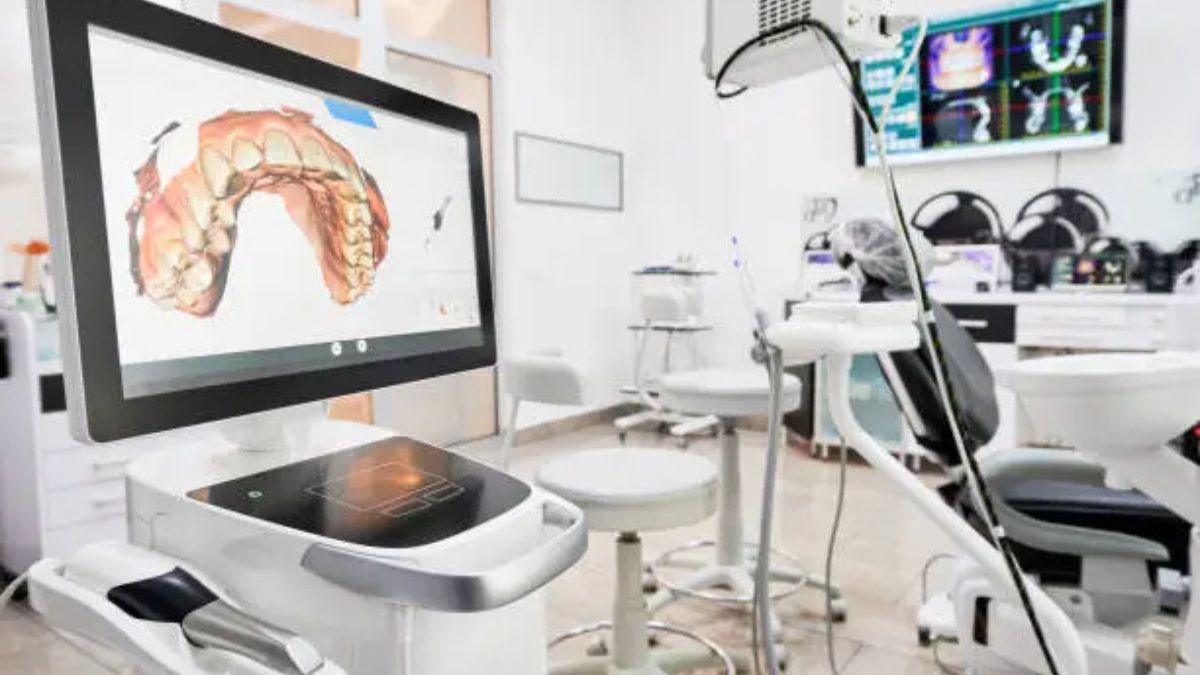HEALTHCARE
The Future of Dental Technology: Innovations Shaping Modern Dentistry

Introduction to Dental Technology
These advancements are not just about improving tools but about enhancing patient experiences and outcomes worldwide. By integrating modern technology into routine practices, dentists can offer more precise, efficient, and comfortable treatment options, translating into higher patient satisfaction and better care outcomes.
The surge of technological integration in dentistry has enabled professionals to tackle complex dental issues with more sophisticated solutions. The ability to diagnose problems promptly using state-of-the-art imaging, crafting precise restorations with 3D printing, and utilizing AI for personalized treatment plans are just a few examples of how technology reimagines dental care. This article explores these exciting developments, providing a glimpse into the potential future of dentistry.
Role of Digital Imaging and 3D Printing
Digital imaging has revolutionized diagnostic accuracy in dental practices. It allows for high-resolution images that enhance the dentist’s ability to identify and treat issues effectively. Dental technology has undergone a significant transformation in recent years, with novel dental equipment fundamentally altering the landscape of oral healthcare. Coupled with this, 3D printing has emerged as a powerful tool for producing dental prosthetics with unmatched precision and customization. This technology reduces production times and costs, making dental care more accessible to a broader audience. Patients benefit from faster, more accurate fittings for crowns, bridges, and dentures, thus minimizing discomfort and visits required for adjustments.
Advancements in Dental Lasers
Dental lasers provide an exciting alternative to traditional methods, dramatically changing procedures like cavity detection and gum surgeries. These advanced tools are not only beneficial for human dentistry but are also increasingly utilized in veterinary products, enhancing animal dental care. Lasers can result in less invasive treatments, as their precision minimizes damage to surrounding tissues. This results in reduced bleeding, faster healing times, and less post-operative pain for human and animal patients. Consequently, patients can enjoy more comfortable experiences and quicker recoveries, encouraging them to remain consistent with follow-up care and preventive measures.
Tele-dentistry: Remote Care Possibilities
Tele-dentistry is an attractive advancement that supports the notion of accessible healthcare for everyone. Patients can consult dental professionals without needing physical visits through video calls and digital communication tools. This is invaluable for individuals in remote locations or those with disabilities that make travel challenging. Remote consultations can provide preliminary diagnoses, second opinions, and even follow-up care, ensuring that patients receive necessary care without the barriers of distance or mobility.
The Rise of Smart Toothbrushes and Dental Apps
Smart toothbrushes use integrated sensors to evaluate brushing patterns and effectiveness and make oral hygiene more personalized and efficient. These devices provide real-time feedback, encouraging users to improve their habits. Additionally, dental apps available on smart devices offer tracking of dental hygiene, educational content, and even gamification to make dental care more engaging. By making everyday oral care data-driven, these technologies help individuals maintain their oral health between visits to the dentist.
Biocompatible and Sustainable Materials
The push towards biocompatible and sustainable materials is gaining momentum as the dental industry seeks safer options for patients and environmentally friendly solutions. These materials minimize the risk of allergic reactions and complications associated with traditional materials used in dental work. They also support the industry’s commitment to eco-friendly practices, ensuring that dental procedures care for patients and the planet. Innovations in this field continue to emerge, promising a healthy future for patients and the environment.
Artificial Intelligence in Dentistry
Artificial Intelligence (AI) is rapidly influencing every facet of dentistry. AI-assisted diagnostics are helping clinicians create highly customized treatment plans by offering tools that can analyze vast amounts of data. These innovations are not confined to diagnostics; they also streamline administrative tasks, allowing dental professionals to focus more on patient care. The future may hold fully automated clinics that can perform specific tasks with minimal human intervention, offering faster and possibly more accurate solutions to dental problems.
Challenges and Considerations
While the technological advancements in dentistry are impressive, they also come with challenges. The costs associated with adopting new technologies can be a barrier for many dental practices, particularly smaller ones. Ethical considerations, such as data privacy in AI tools and equitable access to tele-dentistry, need thorough exploration. Furthermore, ongoing education and training are paramount to ensuring that dental professionals stay abreast of new technologies and techniques, which is crucial for maintaining the quality of care as technologies evolve.
Conclusion
The ongoing technological revolution in dentistry is set to redefine the standards and modalities of care. By embracing these innovations, dental professionals can provide faster, more effective, patient-centered care. As dentistry evolves, these technologies promise to transform dental practices and enhance the quality of life for people around the world. The future of dental care is bright, laden with possibilities that once seemed like science fiction but are quickly becoming the standard of care.
HEALTHCARE
From Road Debris to UV Rays: What Threatens Your Car’s Shine?

Car surfaces are always at risk, which can compromise their durability and appearance. These risks include environmental factors that might damage the paint over time, such as UV radiation, bird droppings, tree sap, and acid rain. Chips, swirl marks, and scratches influence a car’s physical degeneration. Dirt and grime accumulation may cause the surface to lose its brilliance, requiring routine cleaning and maintenance to preserve its structural integrity and brightness.
One effective solution to protect a car’s surface is the application of ceramic coating. Ceramic coating for cars in Las Vegas, NV, offers a durable layer of protection that repels water, dirt, and contaminants, keeping the car’s paint in pristine condition. This protective coating prolongs the paint’s life and lessens the need for regular washings by improving the vehicle’s resilience to scratches and other environmental deterioration. Car owners may maintain the overall appearance of their vehicle while enjoying a high-gloss finish and simple maintenance with ceramic coating.
Understanding Environmental Pollutants
In addition to physical damage risks, cars constantly face an onslaught of environmental pollutants. Though seemingly innocuous, substances like industrial emissions, bird droppings, tree sap, and pollen can eat away at your vehicle’s paint, leading to dullness and eventual damage if not regularly cleaned. The key to managing pollutants is frequent washing and applying protective layers such as wax, which can be a barrier, preventing these contaminants from bonding with your car’s surface.
Impact of Road Debris
Road debris, from tiny stones to loose gravel, can cause serious harm to your vehicle’s paint, compromising its shine and finish over time. Combined with relentless UV rays, these elements accelerate wear, leading to fading, scratches, and a dull appearance. It’s no surprise that more car owners are now searching for automotive ceramic coating near me as they look for ways to defend their vehicle’s finish. A high-quality ceramic coating forms a strong, invisible barrier against harsh elements, helping preserve that showroom gloss while reducing the need for frequent maintenance.
UV Rays and Their Consequences
The blazing sun is not just a summer concern; year-round exposure to UV rays can wreak havoc on your vehicle’s paint. Prolonged sunlight exposure accelerates the oxidation process, where the paint gradually loses its vibrant color, leading to a dull, lifeless appearance. UV rays can also deteriorate the car’s interior, causing fading and cracking of upholstery and dashboards. Utilizing sun shades, parking in shaded areas, and applying UV-protective wax or coatings effectively preserve your car’s vibrance. Ignoring UV protection can result in costly restoration down the line, so it’s beneficial to incorporate these measures into your regular maintenance routine.
Acid Rain: A Silent Menace
Acid rain is real and may harm automobile exteriors, even though it seems like something from a dystopian novel. Rainwater’s acidic chemicals can etch into paint and clear coat, leaving behind ugly stains that are difficult to remove. These marks not only affect the beauty of your car but also weaken the paint’s ability to protect the vehicle from environmental influences. Frequent washes and protective coatings should be standard practice to combat this, especially if you live in an industrial area where acid rain is more prevalent. Regular waxing can act as a buffer, creating a slippery surface that repels pollutants and rain.
Protecting Your Car’s Finish
To keep your car looking its best, it’s essential to invest in quality protective measures. Options like high-quality waxes, sealants, and ceramic coatings offer varying degrees of protection, with ceramic coatings providing incredibly durable and long-lasting defense. These treatments help shield your vehicle from harmful UV rays, chemical etching, and other environmental factors. Applying ceramic coatings is akin to giving your car a shield, offering a robust line of defense against the many threats it faces daily.
Regular Maintenance Strategies
Maintenance is the silent guardian of your vehicle’s gloss and longevity. Routine checks and cleaning ensure contaminants do not get a foothold on your car’s surface. It’s advisable to adhere to a regular schedule for washes and employ microfiber cloths for drying to prevent scratches. A maintenance regime that includes periodic polishes and timely cleaning can preserve the appearance and enhance the vehicle’s value over time. The seemingly small details, like using the right cleaning products and techniques, make a huge difference.
HEALTHCARE
Pregnancy Sex Positions That Are Safe and Comfortable

Having sex when pregnant can be a lovely way to be intimate and connect with your spouse. However, as your body changes, so may your tastes and degree of comfort. The good news? Unless your healthcare practitioner advises you otherwise, having sex during a healthy pregnancy is usually safe. Continue reading to learn about the ideal postures for you and your partner as you navigate this exciting chapter.
Intimacy advice, safe and comfortable Pregnancy Sex Positions, and answers to frequently asked questions will all be covered in this guide.
Is It Safe to Have Sex During Pregnancy?
Yes, for the majority of couples. As long as your doctor hasn’t given you a medical warning against it, having sex during a healthy pregnancy is safe and even encouraged. Abstinence may be advised in cases of placenta previa, preterm labor symptoms, or unexplained vaginal bleeding.
Other advantages of pregnancy sex include reduced stress, improved sleep, and a closer emotional bond with your spouse. As your body changes, keep in mind to put comfort first and talk to your partner about what feels good—or doesn’t.
Best Sex Positions for Each Trimester
Something that feels good in the first trimester may feel uncomfortable in the third due to the distinct physical changes that occur during each trimester. Depending on the stage of pregnancy, these are some of the most comfortable and safest sex positions.
First Trimester
Because of the small size of your baby bulge during the first trimester, you can continue to wear positions that you are accustomed to. Most positions are comfortable at this point, provided you feel capable of handling any side effects, like as weariness or nausea.
- Missionary Position
When there isn’t a significant bump to worry about, this traditional position is ideal for the early stages of pregnancy. Try supporting yourself with a pillow beneath your hips if you start to feel uncomfortable.
- Spooning
Lying side by side allows for gentle, slow intimacy. It’s also a great option if you’re experiencing early pregnancy fatigue.
- Woman on Top
You have control over depth and motion when you’re on top, which makes it a flexible choice at any point throughout pregnancy.
Second Trimester
Exploring various postures is a fantastic idea during the “honeymoon trimester,” which is frequently associated with more energy and decreased nausea. However, some positions become less useful when your belly starts to protrude.
- Spooning (Side-Lying)
This position remains a favorite because it reduces any pressure on your abdomen. Plus, it allows for close, skin-to-skin intimacy.
- Reverse Cowgirl
Similar to “woman on top,” this variation lets you control movement while facing away from your partner. It also keeps weight off your belly.
- Edge of the Bed
Your spouse should stand or kneel in front of you as you lie back on the edge of a firm bed. This position accommodates your growing bulge while reducing back strain.
Third Trimester
Your bulge will probably take up most of your range of motion in the last few weeks of Pregnancy Sex Positions. Avoid anything that feels overly demanding and give priority to positions that take your weight off your abdomen.
- Side-by-Side (Facing Each Other)
Lying on your sides facing each other is intimate, belly-friendly, and manageable this late in pregnancy.
- Doggy Style
Kneeling on your hands and knees can help avoid any pressure on your stomach. Consider leaning forward onto pillows for extra support.
- Modified Sitting Positions
Sitting on your partner’s lap while leaning back against a chair or headboard can offer comfort and connection without putting strain on your belly.
Tips for Comfort and Intimacy
Navigating intimacy during pregnancy includes more than just finding comfortable sex positions. Here are some more pointers to help you and your companion have a good time.
- Use Pillows for Support
Support your bump or back with pillows in different positions. These can make a huge difference as your body adjusts.
- Choose Positions That Minimize Pressure
Avoid positions where your partner is putting direct weight on your abdomen. As your pregnancy progresses, positions that shift this pressure are especially important.
- Communicate Openly
Talking to your partner is crucial throughout pregnancy because it’s a period of both physical and emotional changes. To ensure understanding, discuss what feels good and what doesn’t.
- Use Lubrication
Pregnancy hormones may alter your body’s natural lubrication levels. Opt for a pregnancy-safe, water-based lubricant to increase comfort during sex.
- Take Your Time
Pregnancy is not the time for rushed intimacy. Slow down and enjoy both physical and emotional closeness.
Common Concerns About Pregnancy Sex
Pregnancy brings many questions and concerns about intimacy. Here are answers to some of the most common ones.
- Can Having Sex Harm the Baby?
No, the uterine muscles, the mucus plug that protects the cervix from infections, and the amniotic sac all provide excellent protection for the fetus.
- Can Orgasms Cause Preterm Labor?
Orgasms are usually innocuous, though they can result in minor uterine contractions. Consult your physician, though, if you are experiencing symptoms of preterm labor or a high-risk pregnancy.
- What If I Have No Libido?
Stress, exhaustion, and hormonal fluctuations can all impact your sex drive. This is quite typical. Put your attention on other ways to strengthen your relationship, such as sharing time or snuggling.
When to Consult Your Doctor
Although many couples find that having sex during pregnancy is safe, you should always see your doctor if you suffer from any of the following symptoms after having sex:
Cramping or pain
bleeding from the vagina
Strange discharge
Preterm labor symptoms
Your doctor is there to offer advice and make sure you and your unborn child are safe and healthy.
Maintaining Intimacy Beyond Sex
During pregnancy, there may be many physical and emotional ups and downs. If you’re not constantly in the mood for sex, don’t discount the benefits of connecting in other contexts, like:
Enjoying a quiet meal together
Giving each other massages
Walking or practicing yoga together
Simply touching hands or giving a hug
Small moments of connection can strengthen your relationship even if traditional intimacy is not an option.
Enjoy This Moment of Bonding
Pregnancy-related sex is an opportunity to strengthen your relationship and acknowledge the changes your body is undergoing. This period can be a happy part of your pregnancy experience if you experiment with comfortable sex positions, keep lines of communication open, and concentrate on what feels good for you both.
You should follow your gut and adjust to your comfort level because every pregnancy is different. Enjoy this private and thrilling phase of your relationship above all else.
HEALTHCARE
Thriving in Modern Healthcare: Strategies for Success

Understanding Modern Healthcare Needs
Today’s healthcare landscape is multifaceted and quickly evolving, demanding an approach that places patient-centered care at its core. This means healthcare systems must constantly innovate and adapt to meet the individual needs of their patients.
Technological advancements have transformed traditional care practices, driving providers towards an integrated approach that balances advanced tools with a personalized human touch. Equipped with cutting-edge technologies like AI-driven diagnostic tools and electronic health records, healthcare professionals can deliver more precise and effective treatments. However, it is crucial to maintain a balance, ensuring that technology enhances, not overshadows, the personal connection and trust essential in healthcare.
Building Strong Patient Relationships
Effective communication is pivotal in building strong relationships between healthcare providers and patients. Facilities, such as a skilled nursing home facility Missouri, exemplify these principles by tailoring their services to provide a comprehensive and empathetic care experience that enhances patient well-being. Genuine conversation, empathy, and active listening play a significant role in understanding a patient’s concerns, fears, and expectations. These practices lay the foundations for trust and confidence, essential for patient satisfaction and adherence to treatment plans. By employing personalized care strategies, providers acknowledge each patient’s unique journey, preferences, and cultural backgrounds, thus ensuring they receive practical and respectful care.
A personalized approach does more than treat the ailment; it considers the patient’s lifestyle, tasking healthcare professionals with becoming advocates for holistic health. By integrating wellness education and preventative care strategies, patients are empowered with the knowledge and support required to manage their health actively.
Embracing Technology in Healthcare
With the rise of technology, healthcare is entering an era where digital tools significantly augment patient care. Innovative tools such as wearable health monitors, smart medical devices, and telemedicine platforms are integral to patient management strategies. These advancements grant patients greater access to healthcare services, especially in remote or underserved regions, while offering providers critical insights into patient health trends and data.
Telemedicine has seen a tremendous uptake post-pandemic, as it facilitates remote consultations, ensuring continuity of care even when in-person visits aren’t possible. This shift towards digital health not only cuts down travel and waiting times for patients, enhancing convenience, but also expands the reach of healthcare providers, allowing them to cater to a broader demographic effectively.
Navigating Healthcare Regulations
Compliance with healthcare regulations is non-negotiable and critical for any healthcare operation—regulatory bodies set forth quality and safety standards to protect patients and ensure ethical practices within healthcare settings. Keeping abreast of policy changes and updates is imperative for operational and clinical staff. Regular training workshops and a culture that values compliance can significantly mitigate risks associated with non-compliance, protecting both the facility and its patients.
Staying informed is not merely about avoiding penalties; it is about committing to high standards of patient care. Professional development and continued education in regulatory affairs empower healthcare leaders to drive compliance efforts that meet and exceed expected legal standards.
Fostering Collaborative Environments
The complexity of modern healthcare requires a robust team-based care model. Collaborative practices tap into the varied expertise of interdisciplinary teams, bringing together diverse skill sets that collectively enhance patient care outcomes. Teams that embrace open communication shared decision-making, and a collective vision of quality care can address patient issues more comprehensively.
Effective collaborations break down silos and promote a culture of inclusion and support, where professionals work not in parallel but in partnership. Regular team meetings, clearly defined roles, and mutual respect ensure interdisciplinary collaborations are successful and productive, ultimately delivering a more cohesive and efficient patient care experience.
Enhancing Healthcare Education and Training
Continuous education and advanced training are vital to maintaining a competitive edge in the healthcare industry. With medical science and technology advancing at breakneck speeds, healthcare providers must constantly update their skills and knowledge. Engaging in structured educational programs, attending workshops, and pursuing certifications help professionals stay informed about the latest advancements and best practices.
Mentorship and practical experience also play crucial roles in building a competent healthcare workforce. Seasoned professionals can provide invaluable insights and guidance, helping novices navigate the challenging landscape of healthcare service delivery. Experiential learning opportunities allow healthcare practitioners to apply theoretical knowledge in real-world settings, fostering a deep understanding and proficiency in their field.
Data and Analytics in Healthcare
In the age of digital transformation, data in healthcare is a game-changer. Leveraging big data analytics, healthcare providers can glean critical insights from patient data, transforming how they deliver care. Data analytics enable hospitals and clinics to identify trends, predict health outcomes, and tailor treatments, thereby enhancing the quality of care while reducing costs.
Utilizing data also fosters a proactive approach to healthcare. Predictive analytics can foresee potential health risks, enabling preventative measures and early interventions. This shift from reactive to proactive care improves patient outcomes and optimizes resource allocation, ensuring that healthcare facilities can deliver efficient and personalized services to their communities.
Conclusion: The Future of Healthcare
The future of healthcare is bound by its capacity to adapt and innovate continuously. As technological, educational, and collaborative practices evolve, healthcare organizations must adapt to these new challenges and opportunities. The insights from current healthcare trends suggest a promising horizon filled with expanded capabilities and enhanced care delivery methods.
Facilities investing in technology, patient relationships, and ongoing education pave the way for a healthier, more efficient future care environment. As these elements synergize, the healthcare sector stands prepared not only to meet current demands but to anticipate and adapt to the ever-changing needs of the future.
-

 BLOG1 year ago
BLOG1 year agoEscape to Tranquility Experience Grange Bardage Percheronne in Normandy
-

 LIFESTYLE1 year ago
LIFESTYLE1 year agoAir Jordan 1 Retro High Off-White University Blue
-

 SOCIAL MEDIA1 year ago
SOCIAL MEDIA1 year agoDecoding the Drive Social Media Pyramid Scheme Mystery
-

 LIFESTYLE1 year ago
LIFESTYLE1 year agoAir Jordan 4 Retro Metallic Purple
-

 BLOG6 months ago
BLOG6 months agoDecoding 540-315-8592: From Numbers to Messages
-

 HOW-TO GUIDES1 year ago
HOW-TO GUIDES1 year agoShop Smart and Save with Goldengatemax.shop Online Guide
-

 BUSINESS1 year ago
BUSINESS1 year agoDemystifying 315-442-5267 Common Myths and Facts Revealed
-

 LIFESTYLE1 year ago
LIFESTYLE1 year agoAir Force 1 Shadow Pistachio Frost
